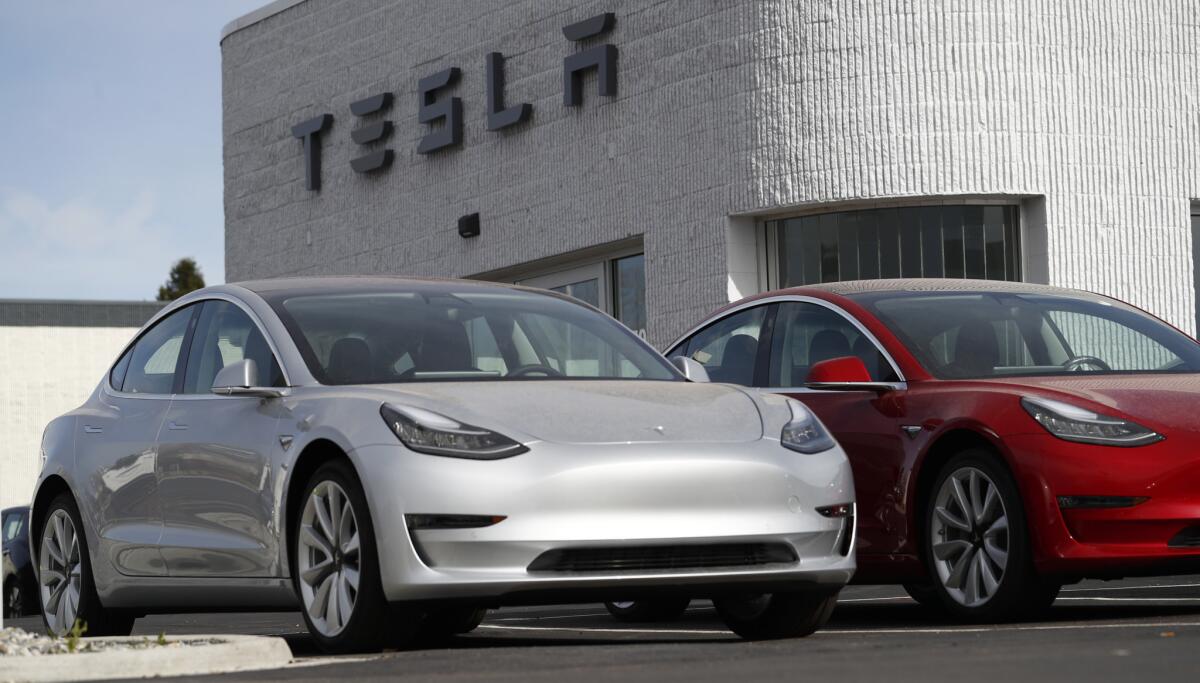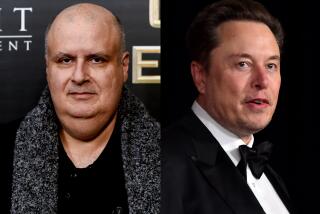Musk has second thoughts on aggressive automation for Tesla Model 3

In early 2017, Elon Musk told stock analysts that Tesla Inc.’s goal “is to be the best manufacturer on Earth.” He’d get there by inventing a factory so dense with robots and devoid of human beings it would resemble an “alien dreadnaught” video game warship.
Speed, he’s said, “is the ultimate weapon when it comes to innovation or production.”
Instead, Tesla this week was forced to bring the Fremont, Calif., production line of its crucial mass-market Model 3 electric sedan to a complete halt, according to the company. It is at least the second shutdown in the last two months. And in an internal email, Musk said Tesla will add workers and go to round-the-clock production to meet goals.
Officially, the company is describing the weeklong shutdown of the Model 3 line as “planned downtime” to “improve automation and systemically address bottlenecks in order to increase production rates.”
Tesla executives hatched the plan weeks ago, a spokesperson said. “This is not unusual and is in fact common in production ramps like this,” the spokesperson said.
Auto industry veterans disagree. Several said that stopping an assembly line for a car in commercial production is not only unusual, it’s exceptional. And manufacturing experts say the retrofits being made during the shutdown will make Model 3 assembly more closely resemble other automobile plants around the world.
“Periodic shutdowns of hours or a day are not uncommon during pre-launch pilot build. They are unheard of in regular production, where he supposedly is,” said Bob Lutz, the former General Motors vice chairman and noted Tesla critic, who has also held top executive positions at Chrysler, Ford and BMW.
“This shutdown is most likely for the purpose of ripping out all the ‘22nd century’ fully-automated assembly systems which were going to ‘revolutionize automotive manufacturing’ and turned out not to work,” Lutz said via email.
Dave Sullivan, an analyst at AutoPacific Inc., said in an email: “Traditional automakers adjust bottlenecks on the fly during a launch. This is totally out of the ordinary.”
The news was another blow to Tesla shareholders, who have seen the stock price recover somewhat after plunging 17% in one week in April on news of production problems, a car crash involving the company’s Autopilot technology and a big recall. Tesla shares fell sharply at the start of trading Tuesday before finishing down 1.2% at $287.69.
The shutdown caught workers by surprise as well. Over the weekend, Tesla ordered Model 3 assembly line workers to not show up for work Monday through Saturday. Take vacation days, they were told, or use up remaining personal days off, or elect not to be paid at all.
Workers were told at the last minute, a Tesla spokesperson said, because “the exact timing (of planned shutdowns) may not be finalized until closer to when it happens.”
But on Tuesday, Tesla said in an internal email it will begin around-the-clock production and add another factory shift in Fremont as it tries to ramp up Model 3 output to 6,000 a week by the end of June. (Musk said the carmaker produced 2,250 of the sedans last week.) Between the Fremont plant and its battery factory, Tesla will be adding about 400 people per week for several weeks, Musk wrote in the email obtained by Electrek.
The company had previously said it was targeting production of 5,000 vehicles a week by around the end of the second quarter.
“The reason that the burst-build target rate is 6,000 and not 5,000 per week in June is that we cannot have a number with no margin for error across thousands of internally and externally produced parts and processes,” Musk wrote.
“We are burning the midnight oil to burn the midnight oil,” he added.
Musk described the 6,000 car last-week-in-June production level as a “burst-build” that will “lay the groundwork” for steadily high production rates a few months from now. That means any given week of production could fall far short, making third quarter production forecasts more uncertain than ever.
The shutdown came just days after Musk appeared on a CBS This Morning segment, admitting that Tesla over-automated the Model 3 assembly line. In the taped segment, CBS This Morning co-host Gayle King was led by Musk on a tour through Tesla’s then-bustling Fremont factory.
Musk sought to reassure viewers that lessons have been learned and that the Model 3 project, considered crucial to Tesla’s continued existence, was back on track. Musk offered few details about automation problems beyond the admission that too many robots were installed. But he did say that “we have this crazy complex network of conveyor belts and it was not working. We got rid of the whole thing.”
The too-many-robots admission appears to be a sobering comedown for Musk, who has said automation would one day become Tesla’s primary business. Today, Tesla builds electric cars, solar energy systems and battery storage devices.
Although he’s famous for warning that humanity should fear the arrival of artificial intelligence, Musk is eager to see robots replace human workers at Tesla. “Parking is one of my biggest nightmares,” he said in 2016, referring to the always-overloaded parking lot at the Fremont plant. “It’s like you can’t fit everyone.”
In the CBS This Morning interview, Musk backpedaled. “Maybe you need more people here working,” King told him. “Yeah, we do,” Musk said. Later that day he tweeted, “Yes, excessive automation at Tesla was a mistake. To be precise, my mistake. Humans are underrated.”
He also copped to over-ambition in the design of the Model 3 in the interview. “We got complacent about some of the things we thought were our core technology, we put too much technology into the Model 3 all at once.” Tesla owner forums are ripe with complaints including dead batteries, body panels that don’t fit right and malfunctions in the input-output screen. Many customer service calls, owners report, result in instructions to reboot the system.
For years, Musk and his lieutenants have said that the Model 3 would be easier to manufacture than the Model X sport utility vehicle, which remains riddled with quality problems, earning low marks in Consumer Reports. “We’re really trying to take a lot of lessons learned from Model X. We put a lot of bells and whistles on Model X and a lot of advanced technologies that weren’t necessary for version one of the vehicle,” Musk said in 2016.
If the Model 3 assembly line cranks back up as scheduled Monday, Musk will be hoping it marks a fresh start. Progress toward Musk’s goal of 10,000 cars a week by the end of December is essential if Tesla is going to fulfill his prediction that the company will generate more cash than it burns in the third and fourth quarters of this year, alleviating the need to raise additional capital.
Analysts such as Efraim Levy at CFRA are skeptical. Barring some sort of “manipulation,” he sees no way Tesla can produce positive free cash flow two quarters in a row this year.
In the CBS interview, Musk dismissed stock analysts.
“The problem a lot of analysts have is they kind of look in the rearview mirror instead of looking out the front windscreen,” he said. “People have underestimated Tesla because they have looked at [what] Tesla’s done in the past and used that as a proxy for what we’re able to do in the future.”
Bloomberg contributed to this report.
UPDATES:
7:41 p.m.: This articles was updated with additional details.
5:05 p.m.: This article has been written through by staff with additional detail and commentary.
This article was originally published at 6:50 a.m.







